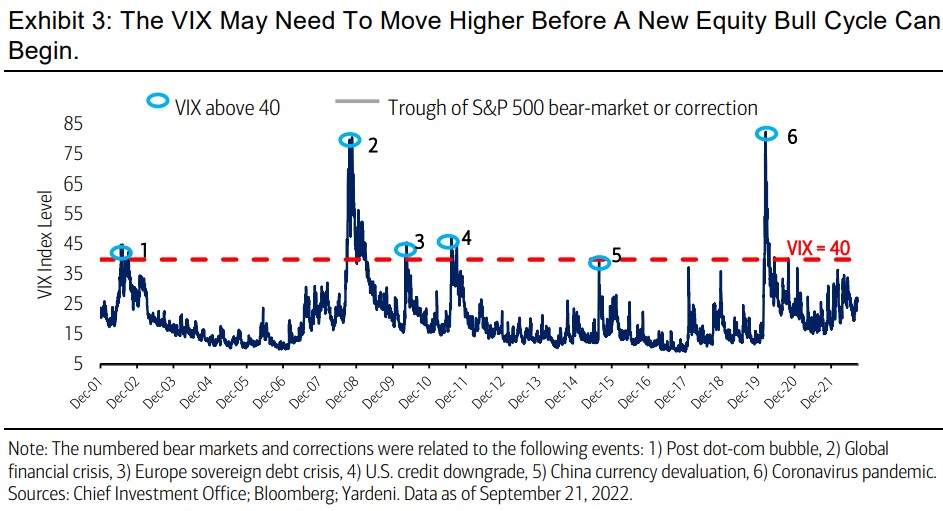Uddrag fra Merill:
Five Triggers To Monitor For A New Equity Bull Cycle
Risk assets have come under some stress recently as an upside surprise to August’s consumer
inflation numbers have led investors to price in more resolute Fed tightening and therefore
higher interest rates for longer. Barring a significant pullback in core inflation (unlikely in our
opinion), portfolio returns in the quarters ahead are likely to underwhelm, and market volatility
should rise, as growth and corporate earnings disappoint.
Our long-held view remains that investors should rely on a disciplined approach to asset
allocation during periods of uncertainty and fade the tendency to time market developments, as
the opportunity cost is vast. However, to aid in the process of rebalancing and potentially putting
cash to work in the quarters ahead, investors should be mindful of signs that could ultimately
indicate the beginnings of a new equity bull cycle. This week, we explore five triggers specific to
this cycle that investors should follow, a combination of which could lay the foundation for the
next sustained equity market uptrend.
Trigger 1—Core inflation moves closer to the Fed’s target: With inflation well above
its 2% target, the Fed is (rightly so) continuing to tighten monetary policy at a historic
pace. Core inflation is currently at 5% to 6% levels and is likely to glide lower as we move
through 2023. However, Equities are likely to begin a new cycle when the Fed pivots to a
balanced focus on inflation and growth as opposed to its singular focus today on crushing
inflationary pressures. It may do this if inflation has moved reasonably closer to its target
(perhaps in the 3% range) and is directionally trending lower. Given that monetary policy
works with a lag, Fed officials may assume at some point that cumulative tightening
already in the system will eventually get them to a 2% inflation target.
Trigger 2—Labor market weakness peaks: Despite tightening financial conditions
and growing concerns about the economic outlook, the labor market has remained
exceptionally tight this year. The unemployment rate remains low at 3.7%, and wages are
rising at a brisk 5%. There are, however, some signs of it cooling, with many prominent
companies announcing plans to freeze hiring and even to institute layoffs. While jobless
claims have been trending lower since July, our expectation is that they will begin to rise in
the months ahead as the economy further loses momentum. A sustained rise in jobless
claims is likely to cool wage pressures at the expense of the economy, adding to the volatile
and uncertain environment for risk assets. Once the adjustment in the supply/demand
imbalance in the labor market has run its course, jobless claims should eventually peak when
employers see improving prospects for top line growth and hire again, providing a tailwind
for Equities.
Trigger 3—Corporate earnings downgrades stabilize: Earnings surprised to the
upside in Q2, with over three-quarters of companies in the S&P 500 Index beating
consensus estimates. But looking forward, cracks are emerging in the earnings picture as
downgrades are finally beginning to come through for the back half of 2022. Consensus
estimates for Q3 decreased by an above-average rate of 5.4% from June 30 to August 31,
marking the largest decrease in estimates during the first two months of a quarter since
Q2 2020. Estimates are also falling for 2023, but they remain far above our forecast
levels which assume a decline of 8%. Importantly, equity markets, to a large extent, may
not yet be factoring in weakening earnings dynamics.
Trigger 4—The U.S. dollar weakens: The U.S. Dollar Index is hovering near multi-decade
highs and several factors supporting dollar strength are unlikely to fade in the near term.
Tightening monetary policy, a global slowdown, geopolitical tensions and growing investor
risk aversion are keeping the dollar elevated, as it is generally seen by investors as a “safe
haven” during times of economic uncertainty. For the dollar to turn around, we would likely
need some combination of a peak Fed tightening cycle, less stress in the global financial
system, some stability in leading indicators for global growth, and a potential return of
investor risk appetite.
Trigger 5—Volatility spikes: Technical indicators like the Chicago Board Options
Exchange (CBOE) Volatility Index (VIX) are not yet at a level that would be considered a
turning point for Equities. One reason volatility, as per the VIX, may be low is that investors
still assume that the Fed may take its foot off the brakes when the economy deteriorates
more broadly. In our view, volatility is dormant but not dead and is likely to rise when the Fed
counters this investor perception by keeping policy tighter for longer. In the past, when the
VIX has topped 40, a trough in an S&P 500 bear market or correction has closely followed
(Exhibit 3). During major equity market selloffs like the 2008/2009 Global Financial Crisis and
the beginning of the pandemic, the VIX went as high as 80. But the VIX only reached a high
of around 35 this year during March and has since collapsed to 27, suggesting that more
volatility may be ahead before we can contemplate a new Equity uptrend.

Conclusion
Reviewing these factors in aggregate, it is our view that there may be more market churn
before Equities eventually converge back into a secular bull market trend. For long-term
investors, reset periods such as these are good opportunities to put capital to work in a
disciplined manner. Investors could consider adding to risk assets in seasonally weak periods
like September and October and then again as earnings estimates start to get reset toward
the end of 2022. There could be opportunities in the first half of 2023, as the Fed begins to
balance both its inflation and growth mandates (in words and certainly in action).





